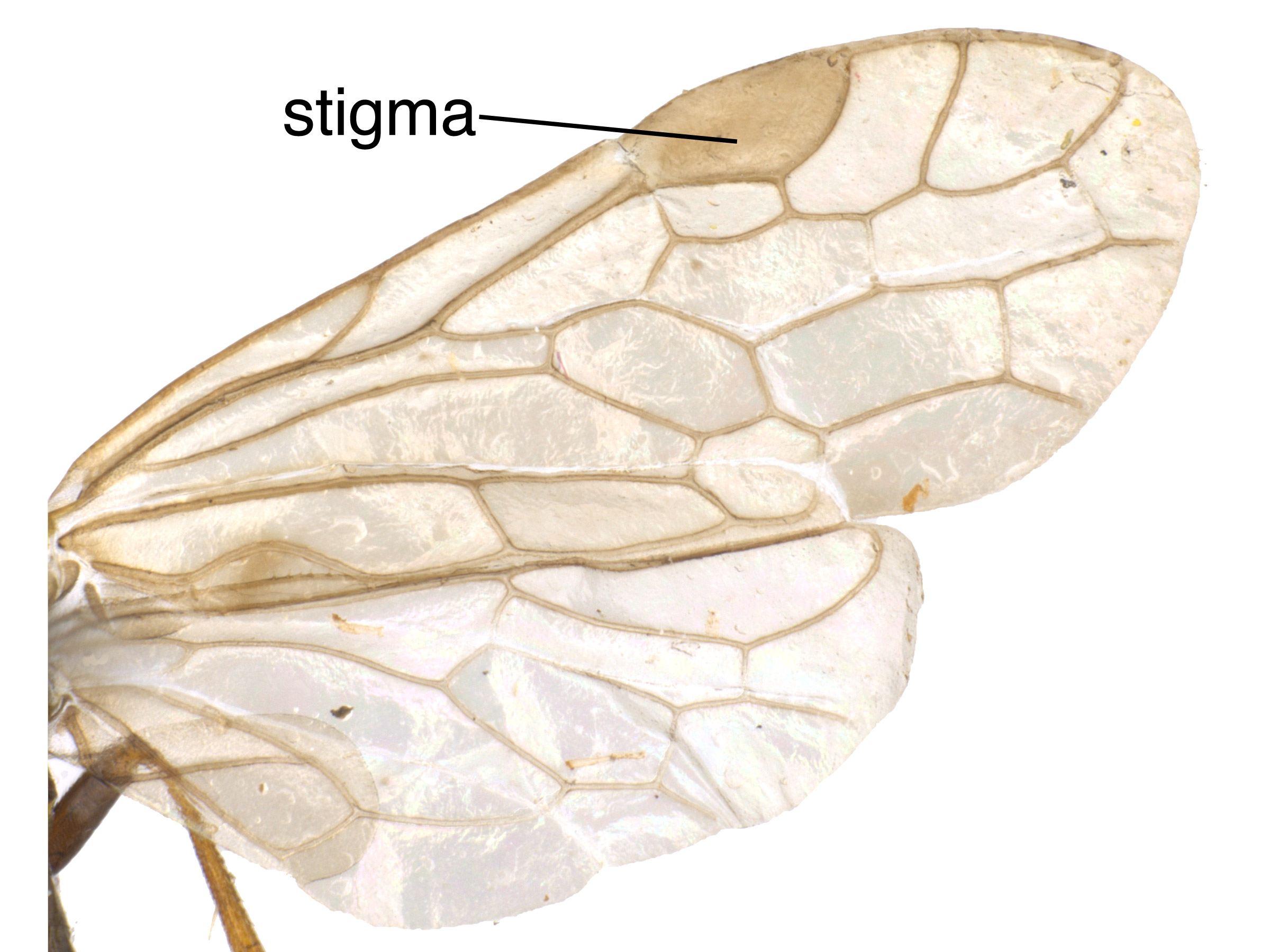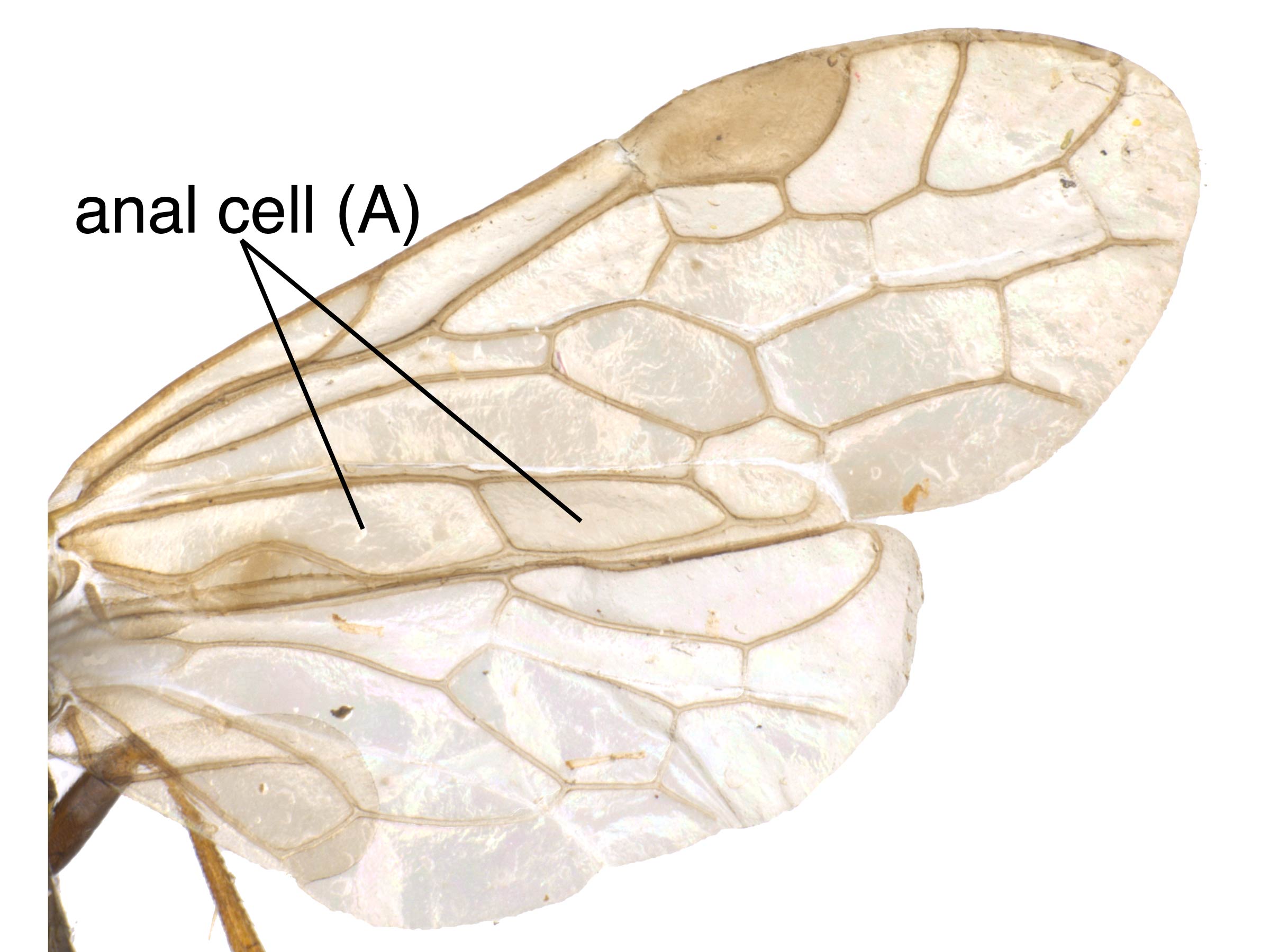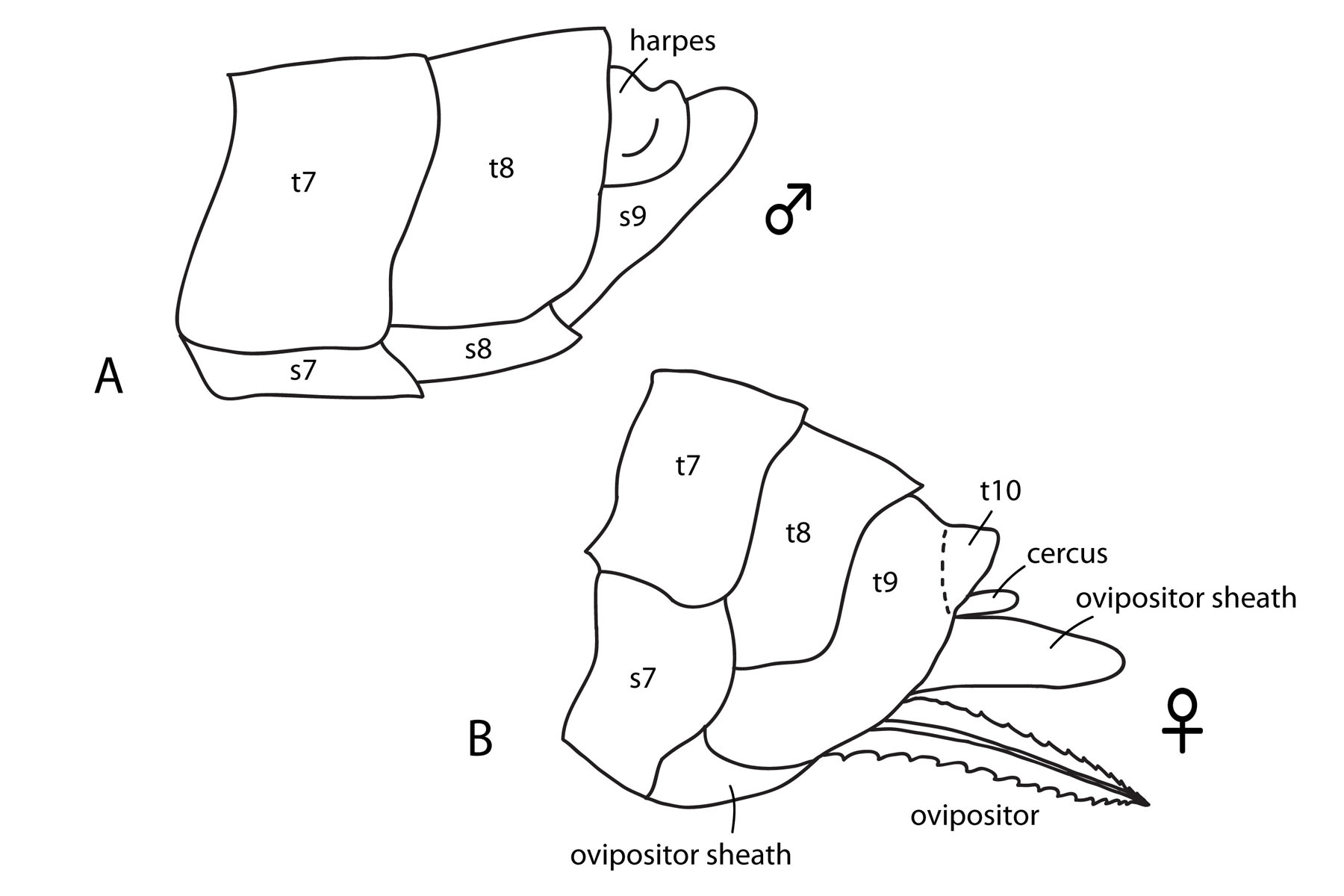Family: Tenthredinidae
Family common name: common sawflies
Subfamily: Nematinae
Tribe: Nematini
Genus: Anoplonyx Marlatt, 1896
Subgenera: none
The Tenthredinidae are the most species-rich family and are found throughout the world, in all continents but Antarctica. They are known as the “common sawflies.” They can generally be recognized by a cylindrical body and long, segmented antennaeantenna:
the sensory organ emerging from the front of the head, usually between the compound eyes and above the clypeus; includes the flagellum, scape and pedicel
 . Otherwise, they come in a variety of colors, sizes, and forms (Goulet 1992Goulet 1992:
. Otherwise, they come in a variety of colors, sizes, and forms (Goulet 1992Goulet 1992:
Goulet H. 1992. The genera and subgenera of the sawflies of Canada and Alaska: Hymenoptera. Symphyta. The insects and arachnids of Canada. Part 20. Agriculture Canada Publication.).
Nematinae is the second-largest subfamily of Tenthredinidae, with over 1,250 species (Prous et al. 2014Prous et al. 2014:
Prous M, Blank SM, Goulet H, Heibo E, Liston A, Malm T, Nyman T, Schmidt S, Smith DR, Varing;rdal H, Viitasaari M, Vikberg V, and Taeger A. 2014. The genera of Nematinae (Hymenoptera, Tenthredinidae). Journal of Hymenoptera Research 40: 1-69. " target="_blank">https://doi.org/10.3897/JHR.40.7442). They are most diverse in northern Eurasia and North America; only a few species occur in the Southern Hemisphere. Nematinae sawflies have a variety of feeding habits including external leaf feeding, leaf mining, and gall forming, and feed on a variety of hosts (Smith 2003bSmith 2003b:
Smith DR. 2003b. A Synopsis of the sawflies (Hymenoptera: Symphyta) of America south of the United States: Tenthredinidae (Nematinae, Heterarthrinae, Tenthredininae). Transactions of the American Entomological Society 129 (1): 1-45.).
The Nematinae have been subject to numerous revisions in recent years. As of 2021, there are no comprehensive keys to many of the North American species of Nematinae (Prous et al. 2014Prous et al. 2014:
Prous M, Blank SM, Goulet H, Heibo E, Liston A, Malm T, Nyman T, Schmidt S, Smith DR, Varing;rdal H, Viitasaari M, Vikberg V, and Taeger A. 2014. The genera of Nematinae (Hymenoptera, Tenthredinidae). Journal of Hymenoptera Research 40: 1-69. " target="_blank">https://doi.org/10.3897/JHR.40.7442). Because of changing taxonomy and extreme variability in morphology, identifying genera and species in the Nematinae may be more challenging than in other subfamilies of Tenthredindae. For this reason, knowing the host or behaviors of a specimen can be extremely helpful for identification within this subfamily.
Anoplonyx are about 5 mm in length and mostly black in color, with variable pale markings and clear wings (Bracken 1961Bracken 1961:
Bracken DF. 1961. The external morphology of two eastern species of the genus Anoplonyx (Hymenoptera: Tenthredinidae), with special reference to Anoplonyx luteipes (Cresson). The Canadian Entomologist 93: 573-593.).
There are 12 described species worldwide. Four species occur in North America (Taeger et al. 2018Taeger et al. 2018:
Taeger A, Liston AD, Prous M, Groll EK, Gehroldt T, and Blank SM. 2018. ECatSymmdash;Electronic World Catalog of Symphyta (Insecta, Hymenoptera). Program version 5.0 (19 Dec 2018), data version 40 (23 Sep 2018). Senckenberg Deutsches Entomologisches Institut (SDEI), Muuml;ncheberg. https://sdei.de/ecatsym/ Accessed: 28 Jan 2020.).
Subfamily characters
 (Goulet 1992Goulet 1992:
(Goulet 1992Goulet 1992: vein 2A+3A incomplete and straight (Prous et al. 2014Prous et al. 2014:
vein 2A+3A incomplete and straight (Prous et al. 2014Prous et al. 2014: vein 2m-cu meeting cellcell:
vein 2m-cu meeting cellcell: 1Rs above (Goulet 1992Goulet 1992:
1Rs above (Goulet 1992Goulet 1992:Genus characters
 3X as wide as long (Goulet 1992Goulet 1992:
3X as wide as long (Goulet 1992Goulet 1992: cellcell:
cellcell: 1M slightly constricted apically (Goulet 1992Goulet 1992:
1M slightly constricted apically (Goulet 1992Goulet 1992: veins M and Rs+M relatively widely separated on veinvein:
veins M and Rs+M relatively widely separated on veinvein: R (Goulet 1992Goulet 1992:
R (Goulet 1992Goulet 1992: vein 2A+3A curved upwards and meeting 1A (Goulet 1992Goulet 1992:
vein 2A+3A curved upwards and meeting 1A (Goulet 1992Goulet 1992: vein 2A meeting 1A; basalbasal:
vein 2A meeting 1A; basalbasal: present (Goulet 1992Goulet 1992:
present (Goulet 1992Goulet 1992: without inner tooth (Goulet 1992Goulet 1992:
without inner tooth (Goulet 1992Goulet 1992: relatively wide, about 2–4X as long as wide (Goulet 1992Goulet 1992:
relatively wide, about 2–4X as long as wide (Goulet 1992Goulet 1992:Anoplonyx can be distinguished from other genera of Nematinae that have fore wingfore wing:
the anterior wing of each pair of wings; usually the largest wing of the pair
 vein 2A+3A curved upwards by the symmetrical outer surfaces of the mandibles, the connection of veinvein:
vein 2A+3A curved upwards by the symmetrical outer surfaces of the mandibles, the connection of veinvein:
a tube-like, often darkened, structure on the wings
 2m-cu to cellcell:
2m-cu to cellcell:
1. a membranous area of the wing between veins, 2. a small cavity or closed space
 1Rs, and the tarsal clawtarsal claw:
1Rs, and the tarsal clawtarsal claw:
sharpened appendage emerging from the apex of the tarsus
 without an inner tooth (Goulet 1992Goulet 1992:
without an inner tooth (Goulet 1992Goulet 1992:
Goulet H. 1992. The genera and subgenera of the sawflies of Canada and Alaska: Hymenoptera. Symphyta. The insects and arachnids of Canada. Part 20. Agriculture Canada Publication.).
Anoplonyx destructor is known to be a pest in the United Kingdom on Larix decidua (European larch), Larix kaempferi (Japanese larch), and hybrids. Though infestations occur, damage is rarely severe (Crooke 1953Crooke 1953:
Crooke M. 1953. Some notes on Anoplonyx destructor Benson. Bulletin of Entomological Research 44: 77-81.).
Anoplonyx feeds on species of Larix (larch), including Larix occidentalis (western larch) and Larix laricina (tamarack) (Goulet 1992Goulet 1992:
Goulet H. 1992. The genera and subgenera of the sawflies of Canada and Alaska: Hymenoptera. Symphyta. The insects and arachnids of Canada. Part 20. Agriculture Canada Publication.).
Females oviposit into small slits cut into the needles of the host, usually one egg per needle. LarvaeLarva:
the immature stage of holometabolous insects
 are green with dark stripes (Bracken 1961Bracken 1961:
are green with dark stripes (Bracken 1961Bracken 1961:
Bracken DF. 1961. The external morphology of two eastern species of the genus Anoplonyx (Hymenoptera: Tenthredinidae), with special reference to Anoplonyx luteipes (Cresson). The Canadian Entomologist 93: 573-593.). At maturity, larvaelarva:
the immature stage of holometabolous insects
 fall to the ground and spin cocoons in the leaf litter, where they overwinter and subsequently pupate in the spring (Crooke 1953Crooke 1953:
fall to the ground and spin cocoons in the leaf litter, where they overwinter and subsequently pupate in the spring (Crooke 1953Crooke 1953:
Crooke M. 1953. Some notes on Anoplonyx destructor Benson. Bulletin of Entomological Research 44: 77-81.).
World: The genus is known from North America, central, northern, and eastern Europe, through Russia, Mongolia, China, and Japan (Taeger et al. 2018Taeger et al. 2018:
Taeger A, Liston AD, Prous M, Groll EK, Gehroldt T, and Blank SM. 2018. ECatSymmdash;Electronic World Catalog of Symphyta (Insecta, Hymenoptera). Program version 5.0 (19 Dec 2018), data version 40 (23 Sep 2018). Senckenberg Deutsches Entomologisches Institut (SDEI), Muuml;ncheberg. https://sdei.de/ecatsym/ Accessed: 28 Jan 2020.).
North America: Anoplonyx occurs throughout Canada, as far north as Yukon (Woods 1962Woods 1962:
Woods TAD. 1962. Occurrence of Anoplonyx spp. In the larch forests of British Columbia and Yukon Territory. Proceedings of the Entomological Society of British Columbia 59: 17.), and throughout the northern United States, with a southern extension into Mississippi (GBIF).
Map data from: GBIF.org (29 October 2019) GBIF Occurrence Download Anoplonyx
Details about data used for maps can be found here.